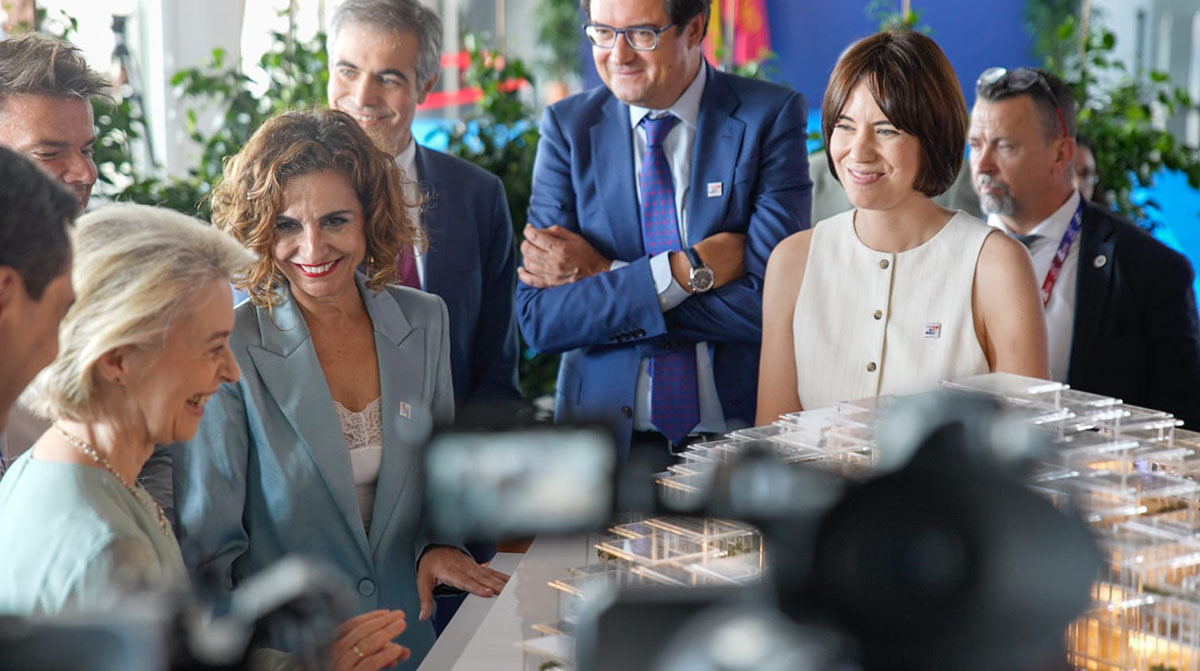Montero defends scientific backing for EU policies as work starts on the Joint Research Centre in Seville
News - 2025.7.1
 The First Vice-President, María Jesús Montero, the Minister for Digital Transformation, Óscar López, the President of the European Commission, Úrsula von der Leyen and the Minister for Science, Diana Morant
The First Vice-President, María Jesús Montero, the Minister for Digital Transformation, Óscar López, the President of the European Commission, Úrsula von der Leyen and the Minister for Science, Diana Morant
María Jesús Montero, first vice-president and minister for treasury, attended the ceremony to lay the foundation stone of the new building of the European Commission's Joint Research Centre (JRC) in Seville, where she stressed the importance of the support of scientific evidence when it comes to implementing the EU's different policies.
She also pointed out that the location of this centre in Seville demonstrates that Europe is very present in Spain and Andalusia, while at the same time it also reflects the Government of Spain's commitment to Europe.
The event was also attended by the President of the European Commission, Ursula von der Leyen, as well as other EU, national, regional, and local authorities.
The JRC is the European Commission's science service and knowledge centre, which employs researchers to provide independent scientific evidence and evidence-based advice in support of most EU policies.
It is distributed across six sites in five European countries: Brussels and Geel (Belgium), Seville (Spain), Ispra (Italy), Karlsruhe (Germany), and Petten (Netherlands). The construction of this new building consolidates the European Commission's commitment to Seville, positioning the Andalusian capital as a pole of scientific excellence and a reference point from which to promote high quality research in key areas for the EU.
During the laying of the first stone, a time capsule was introduced, where the first vice-president presented a coin dedicated to the researcher Margarita Salas, as a tribute to the woman scientist and to serve as an inspiration to new generations of girls who can see themselves reflected in her.
Presence since 1994
On 15 April 1994, the European Economic Community, the European Atomic Energy Community (EURATOM), and the Kingdom of Spain signed an agreement on the establishment of the 'Instituto de Prospectiva Tecnológica' in Seville, in the 'World Trade Center Expo' building in the Science and Technology Park on the island of La Cartuja in Seville, whereby Spain placed at the disposal of the European Commission a number of offices and parking spaces in the building.
The evolution of the European Commission's operational needs and resources over the last decades has led to the need to consolidate the JRC's presence in Seville through the construction of a new building. To this end, Seville City Council has granted the European Commission a concession for the free use of a plot of land located on the island of La Cartuja for 75 years.
These new facilities will be built according to a design by the studio of the Danish architect Bjarke Ingels, in accordance with the principles of the New Bauhaus, which was selected through an international design competition. The new building is scheduled for final occupation in 2027.
It is intended to be a unique facility, to which the Government of Spain will make an annual contribution over the next few years, thanks to the Headquarters Agreement between the European Commission and the Government of Spain. This agreement replaces the agreement signed on 15 April 1994.
Knowledge hub
The JRC is a centre where researchers analyse key areas for the development of policies implemented by the EU, providing customised scientific and technical support for the conception, development, implementation, and monitoring of these policies.
During the event held in Seville, the first vice-president and minister for treasury expressed Spain's commitment to the European project, recalling the shared values and principles based on respect for human rights, freedom, tolerance, solidarity, cohesion, and the peaceful coexistence of peoples.
María Jesús Montero stressed that Europe "guarantees and protects the Welfare State", while at the same time "knows that the answers to the challenges of the present and the dreams of the future lie in science, in innovation, and in unity, in the ability to cooperate and work together".
Montero highlighted the value of this new European Commission centre, a symbol of collaboration and attraction of talent, which functions as "a top-level hub for projects related to the ecological transition, the circular economy, sustainability and artificial intelligence, providing evidence and scientific solidity to European policies, knowledge that allows public decision-makers to adopt the best possible decisions in the face of increasingly complex and multidisciplinary problems".
In this regard, she stressed the importance of science for the Government and that this should be a "guiding principle" in policy, after which she recalled that the Executive has doubled the budget for Science since 2018, and has promoted the National Scientific Advisory Office. "For science to guide our actions as a lever for progress", the first vice-president underlined.
Non official translation




